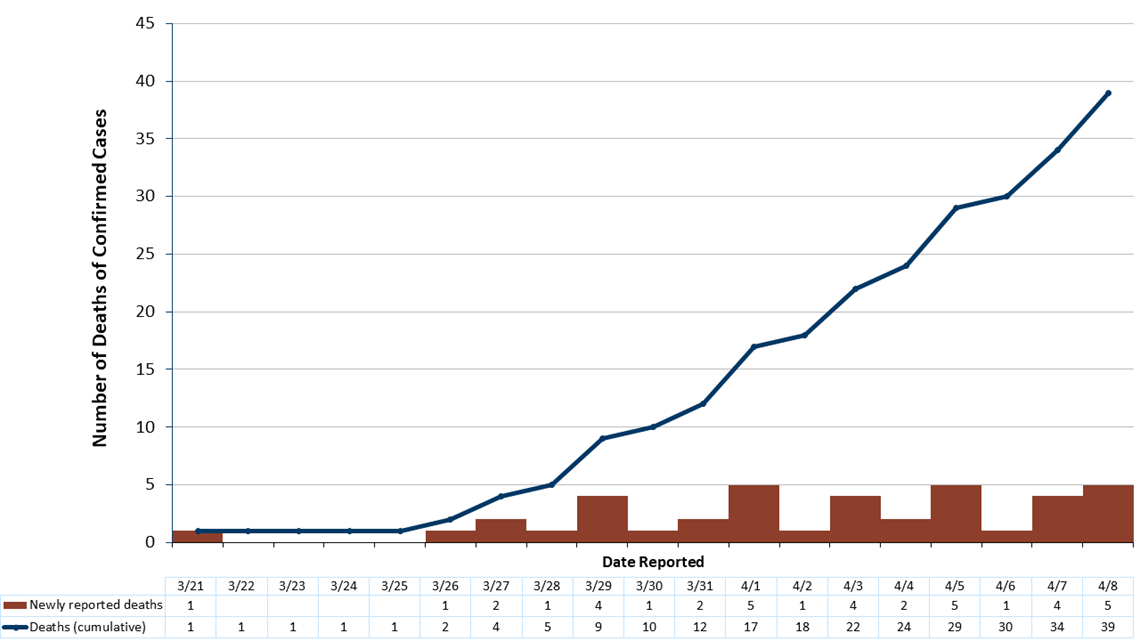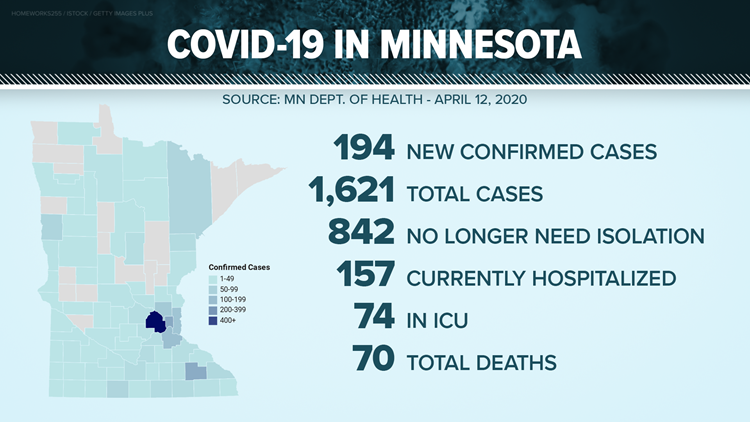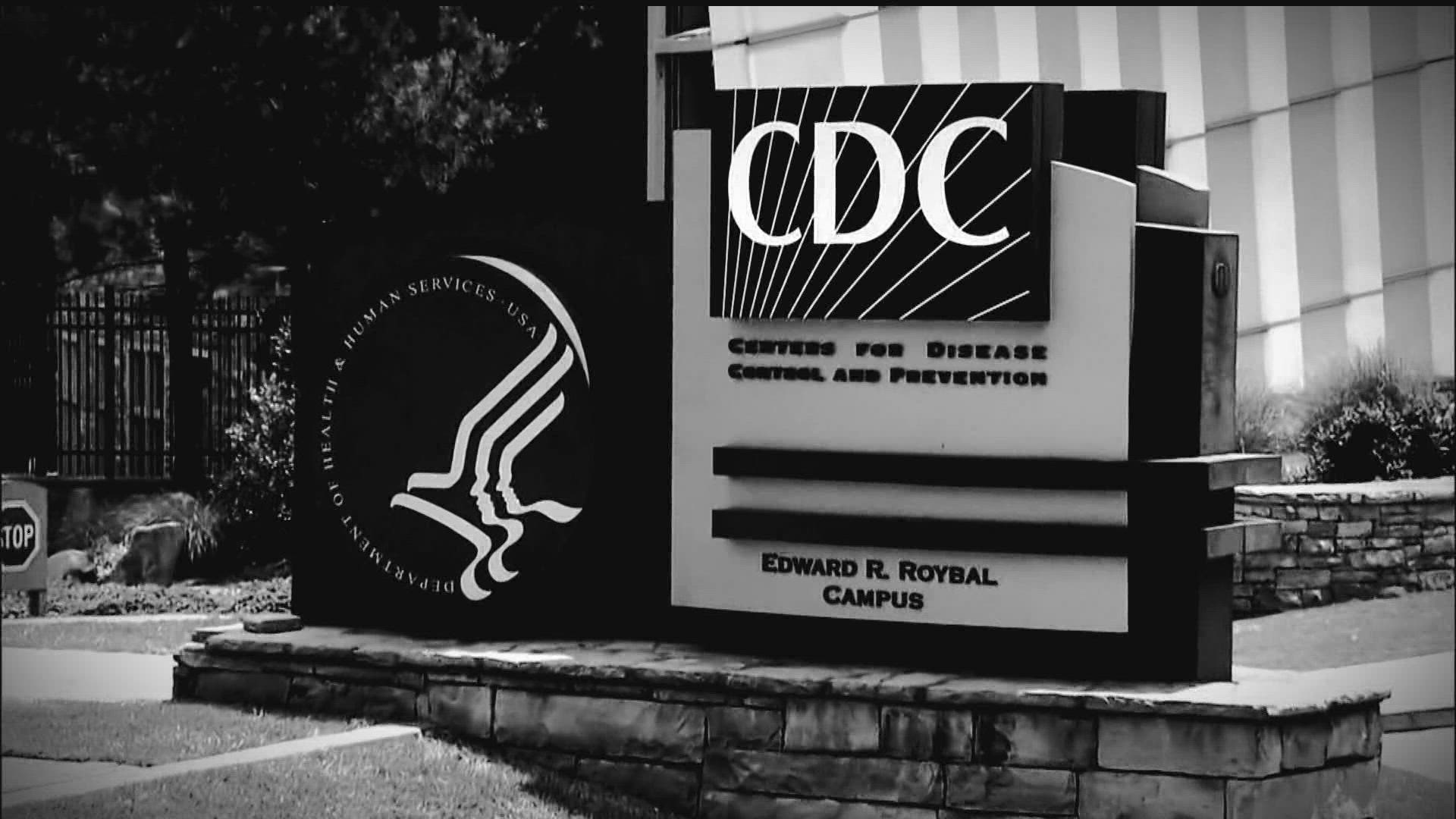Sunday, April 12
2 p.m.
The Wisconsin Department of Health released it's latest COVID-19 figures for the state on Sunday.
Wisconsin now has 3,341 confirmed positive cases up from 3,213 on Saturday. Deaths have risen to 144, up from Saturday's 137.
Of those deaths, 88 have occurred in Milwaukee County.
Wisconsin health officials say a total of 974 people have been hospitalized with complications from the coronavirus since the start of the pandemic, 29% of those who have tested positive.
Of those testing positive for the coronavirus, 20% are between the ages of 50 and 59; 18% are 60 to 69; and 16% are from 40 to age 49.
Fifty-three percent of those testing positive are female as compared to 47% male, but men make up a larger percent of the state fatalities at 60%.
Milwaukee County has the most cases at 1,710, while Dane, Waukesha and Kenosha Counties report 334, 209 and 173 positive cases respectively.
11 a.m.
The Minnesota Department of Health (MDH) has identified 194 new coronavirus cases in the state. MDH announced another six deaths, which brings the statewide total to 70. The total number of cases is 1,621 as of April 12, which is up from 1,427 on Saturday. In a press released earlier this morning, MDH reported 1,536 total cases but additional cases, which would have typically been reflected in Monday's report, were included.
MDH says 361 of those cases in total have required hospitalization, and 157 are still hospitalized while 74 are in intensive care. There are 842 patients of the total who no longer need to be isolated.
Approximately 9,385 of tests have been done by the MDH Public Health Lab. And approximately 28,036 have been done by external laboratories.
Hennepin County has the most cases at 557. Ramsey County has reported 152 cases, followed by Olmsted County with 143 cases.
Saturday. April 11
2:30 p.m.
The Wisconsin Department of Health released it's latest COVID-19 figures for the state on Saturday.
Wisconsin now has 3,213 confirmed positive cases up from 3,068 on Friday. Deaths have risen to 137, up from Friday's 128.
Of those deaths, 85 have occurred in Milwaukee County.
Wisconsin health officials say a total of 950 people have been hospitalized with complications from the coronavirus since the start of the pandemic, 30% of those who have tested positive.
Of those testing positive for the coronavirus, 19% are between the ages of 50 and 59; 18% are 60 to 69; and 16% are from 40 to age 49.
Fifty-three percent of those testing positive are female as compared to 47% male, but men make up a larger percent of the state fatalities at 61%.
Milwaukee County has the most cases at 1,653, while Dane, Waukesha and Kenosha Counties report 327, 201 and 163 positive cases respectively.
11:30 a.m.
The Minnesota Department of Health (MDH) has identified 91 new coronavirus cases in the state. MDH announced another seven deaths, which brings the statewide total to 64. The total number of cases is 1,427 as of April 11, which is up from 1,336 on Friday.
MDH says 340 of those cases in total have required hospitalization, and 145 are still hospitalized while 69 are in intensive care. There are 793 patients of the total who no longer need to be isolated.
Approximately 9,292 of tests have been done by the MDH Public Health Lab. And approximately 26,112 have been done by external laboratories.
Hennepin County has the most cases at 464. Olmsted and Ramsey County follow with 132 cases each.
Friday, April 10
6 p.m.
Governor Tim Walz has issued Emergency Executive Order 20-32, which authorizes the limited sharing of public health information from the Commissioner of Public Health to first responders and the Department of Public Safety.
According to a release from the State of Minnesota's Executive Department, emergency personnel will be supplied with addresses containing individuals who have tested positive for COVID-19 and are still contagious.
The release says no identifying information will be shared beyond a person's address, and addresses can only be shared with the Department of Public Safety (DPS), 911 dispatchers and first responders.
Governor Walz believes this will enable these emergency workers to properly socially distance themselves, and preserve their own health, while preventing the spread of COVID-19.
The release states that only the addresses of individuals the Minnesota Department of Health (MDH) had detected to have COVID-19 will be shared.
MDH is required by this order to notify DPS when it believes addresses no longer contain contagious individuals, at which point DPS is required to delete the information from their database.
Emergency workers and public safety workers who receive the shared health information can only use that information to the extent it protects their own health and the health of their fellow workers.
The order remains in effect until Walz's former peacetime emergency declaration (issued as Executive Order 20-01) is "terminated or rescinded by proper authority."
11 a.m.
The Minnesota Department of Health said Friday that seven more Minnesotans have died of complications from the coronavirus, bringing the total of lives lost to 57 since the pandemic swept into the state.
Statistics from the department's daily report say the number of Minnesotans testing positive is now up to 1,336, a jump of 94 from the 1,242 reported Thursday. Nobles County is the only new county added to the list of those reporting a positive test for the coronavirus.
Of those testing positive for COVID-19, a total of 317 have required hospitalization. Health officials say 143 are currently hospitalized as of Friday, with 64 being treated in the ICU.
The number of patients diagnosed with the coronavirus that are recovering is also increasing: MDH says 732 of those who have tested positive no longer require isolation.
Those 20 to 44 years old represent the largest number of patients who have tested positive with 505 cases, followed by those 45 to 64 years old with 451 cases. Females make up 52% of those diagnosed with COVID-19.
MDH says 31% of those confirmed with coronavirus were exposed during travel, 19% through congregate living (either a resident or staff member), 16% through community transmission and 15% working in a health care setting.
10 a.m.
Minnesota's hospitals and health systems are asking the state's congressional delegation to secure federal emergency funds that will help make up for losses related to the coronavirus that will near $3 billion over the next 90 days.
Leadership with the Minnesota Hospital Association (MHA) says the funds will help ensure that hospitals and health systems get through this pandemic, and then be viable to help patients across the state once the worst of the pandemic passes.
“Minnesota’s health care providers have postponed elective surgeries and reduced in-person visits to clinics in order to conserve personal protective equipment (PPE) for front-line caregivers and to reduce potential exposure for both health care workers and patients,” said Dr. Rahul Koranne, president and CEO, MHA. “The reduction in revenues and significant costs to acquire an unprecedented amount of supplies and equipment, build out temporary spaces for a surge of patients and ensure we will have the right workforce in place to care for COVID-19 patients – particularly in intensive care – are having a significant financial impact on health systems throughout Minnesota, large and small, metro and rural.”
MHA worked with accounting firm CliftonLarsonAllen to formulate a financial model to gauge the near-term impact of this pandemic. Here are their findings.
- Minnesota hospitals and health systems are collectively losing $31 million in revenue per day as a result of reductions in patient volumes. This represents a 55% reduction of patient revenues, on average. Smaller hospitals are reporting closer to 70% revenue reductions. This loss is expected to remain consistent over at least the next 90 days for an impact of $2.8 billion.
- MHA members as a whole are spending approximately $13.3 million per day to purchase equipment and supplies and to make physical and technological upgrades that will allow them to handle a surge of COVID-19 patients. Over 90 days, these additional expenses will total $1.2 billion.
- The analysis also accounted for offsetting revenues as COVID-19 cases increase. With an estimated shortfall from reimbursements, hospitals and health systems will experience over $120 million in uncovered patient-related costs.
- In total, this will result in approximately a $2.9 billion cash flow loss over the next 90 days.
Thursday, April 9
2 p.m.
In Gov. Tim Walz's first public update since extending Minnesota's "Stay at Home" order, he and state health officials said they are taking the "long view."
The governor took a moment to acknowledge that 11 more people have died from COVID-19 in the state, bringing the total to 50. Walz said those deaths represent the trajectory of the disease, and said that's why he issued an extension of the order, "to ensure that everyone gets the hospital room they need, gets the fighting chance to make sure that they come through this."
“We can’t let wishful thinking drive us, we need to be driven by the developments around COVID-19, the things that we're doing that work, we need to be nimble enough to pivot and change when we can," he said.
Along with the extension, Walz wrote a provision into the new order that allows a state working group to build protocols to allow some more businesses to get back to work, if they can do so while following hygienic and social distancing guidance from public health officials.
Walz said some employers have already been contacted by the state, which is "starting to figure out" what those protocols look like.
The governor has said that the social distancing measures the state is taking could push the virus "peak" out to early July. The peak is defined by the health department as the maximum number of people infected and needing hospital and ICU care on any given day. The state expects that surge to be anywhere from 3,000 to 5,000 people.
On the daily briefing call with the governor, state health officials and the media, Minnesota Department of Health Commissioner Jan Malcolm said that Minnesota is taking a long view, and that staying 6 feet from other people and being vigilant of handwashing "are going to stay with us for a long time."
Walz said that public health officials are predicting three waves in the next 12 to 18 months.
"We’re trying to figure out, what is the most sustainable way without the incredible disruption that is not sustainable on the economy, to be able to get as many folks back," he said. "We’ve got to find a place that works long term and is not just shelter in place alone."
Minnesota will learn from Hong Kong, Japan and Korea, Walz said, as they face subsequent waves of the virus.
With many religious holidays approaching, Walz urged the public to keep social distancing, washing their hands, and avoiding large gatherings.
"This is a very important week for billions around the world," he said.
Malcolm said that the rate of doubling - an important indicator of the spread of the virus - has remained stable. On Wednesday, she reported that it was doubling about once every eight days, down significantly from the beginning of the outbreak.
Malcolm said of the 11 people whose deaths were reported Thursday, three were in their 70s, four were in their 80s and four were in their 90s.
In response to online speculation about the reported numbers of deaths, Malcolm said, "There is absolutely no policy or political motivation to increase the number of deaths that are reported."
Director of Homeland Security and Emergency Management Joe Kelly said his team is "making use of the extra time that we've been given to get ready" for the peak of coronavirus cases in Minnesota.
Kelly said they are asking FEMA to finance shelters for people who test positive for COVID-19 and don't have a way to isolate. This could mean people who are experiencing homelessness, don't want to expose other people in their household, or don't have a safe place to go.
Kelly said he plans to put these people up in hotel rooms, dorm rooms, and other similar places until their isolation period is over, with FEMA helping to pay for the plan.
Department of Employment and Economic Development Steve Grove said unemployment applications are down this week from last week. He said they have cleared more than 236,000 applications that are eligible for the extra $600 federal benefits, totaling more than $141 million.
Grove continues to ask people to apply at UIMN.org, instead of calling the helpline. However, for those who need to call, he said morning is a better time to get through. Those numbers are 651-296-3644 for the Twin Cities area and 1-877-898-9090 for greater Minnesota. There are certain days dedicated to specific types of questions, listed here.
Walz responded to concerns about food supply disruption in the wake of the temporary closure of a Smithfield Foods, Inc. facility in Sioux Falls. The facility is closing for three days after "a portion" of their employees tested positive for coronavirus.
Walz said at this time he does not believe there is a disruption to the food supply in Minnesota but "that is our deep concern."
Walz said he believes that rapid testing will help factories like these get back up and running, calling it a "Minnesota moon shot" to make that kind of testing widely available in the state.
"I'm envisioning us being able to test 10s of 1,000s on the spot daily going forward," he said.
Walz said the national supply of these rapid tests is lacking, and he thinks "Minnesota needs to take this on."
"This is not a magic fix that's here today," Walz clarified. "It's very, very promising. ... There are still hurdles to overcome but I do believe it's a path forward."
Walz said he disagrees the decisions he is making are unilateral. He said his decisions are based on data from health experts and from hospitals who say they are not ready for the surge of cases. He added that no matter what model different states are using, they have all made similar decisions.
11 a.m.
Minnesota Governor Tim Walz has extended the state's Stay at Home order, insisting that the battle against COVID-19 is not over and numbers released Thursday by the Minnesota Department of Health (MDH) support that.
Health officials are reporting 11 new deaths from complications of the coronavirus, bringing the total to 50 since the pandemic began. That is the largest one-day surge in fatalities that MDH has reported.
The number of people testing positive for COVID-19 is now up to 1,242, an increase of 88 cases from Wednesday. MDH says 293 total patients have been hospitalized since they started tracking in late January, with 145 currently in hospitals. Sixty-three of those cases are serious enough to be in the ICU.


The majority of those who contracted the coronavirus have recovered, or are continuing to recover. MDH says 675 of them no longer require isolation.
Minnesotans have taken 32,294 tests for the COVID-19 virus, with 23,202 of those tests being processed in non-MDH labs.Statistics show the median age of all people testing positive is 51, with the youngest being 4 months and the oldest 104 years old. The median age of those dying from the coronavirus is 87, while the median of all patients requiring hospitalization for the virus is 64.
KARE 11’s coverage of the coronavirus is rooted in Facts, not Fear. Visit kare11.com/coronavirus for comprehensive coverage, find out what you need to know about the Midwest specifically, learn more about the symptoms, and see what companies in Minnesota are hiring. Have a question? Text it to us at 763-797-7215. And get the latest coronavirus updates sent right to your inbox every morning. Subscribe to the KARE 11 Sunrise newsletter here. Help local families in need: www.kare11.com/give11.
The state of Minnesota has set up a hotline for general questions about coronavirus at 651-201-3920 or 1-800-657-3903, available 7 a.m. to 7 p.m. There is also a data portal online at mn.gov/covid19.
More information on the coronavirus:



